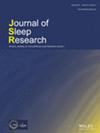Profiling the sleep architecture of ageing adults using a seven‐state continuous‐time Markov model
IF 3.4
3区 医学
Q2 CLINICAL NEUROLOGY
引用次数: 0
Abstract
SummarySleep is a complex biological process regulated by networks of neurons and environmental factors. As one falls asleep, neurotransmitters from sleep–wake regulating neurones work in synergy to control the switching of different sleep states throughout the night. As sleep disorders or underlying neuropathology can manifest as irregular switching, analysing these patterns is crucial in sleep medicine and neuroscience. While hypnograms represent the switching of sleep states well, current analyses of hypnograms often rely on oversimplified temporal descriptive statistics (TDS, e.g., total time spent in a sleep state), which miss the opportunity to study the sleep state switching by overlooking the complex structures of hypnograms. In this paper, we propose analysing sleep hypnograms using a seven‐state continuous‐time Markov model (CTMM). This proposed model leverages the CTMM to depict the time‐varying sleep‐state transitions, and probes three types of insomnia by distinguishing three types of wake states. Fitting the proposed model to data from 2056 ageing adults in the Multi‐Ethnic Study of Atherosclerosis (MESA) Sleep study, we profiled sleep architectures in this population and identified the various associations between the sleep state transitions and demographic factors and subjective sleep questions. Ageing, sex, and race all show distinctive patterns of sleep state transitions. Furthermore, we also found that the perception of insomnia and restless sleep are significantly associated with critical transitions in the sleep architecture. By incorporating three wake states in a continuous‐time Markov model, our proposed method reveals interesting insights into the relationships between objective hypnogram data and subjective sleep quality assessments.利用七状态连续时间马尔可夫模型分析老龄成人的睡眠结构
摘要睡眠是一个复杂的生物过程,受神经元网络和环境因素的调节。人在入睡时,来自睡眠-觉醒调节神经元的神经递质会协同工作,控制整夜不同睡眠状态的切换。由于睡眠障碍或潜在的神经病理学可能表现为不规则的切换,因此分析这些模式对睡眠医学和神经科学至关重要。虽然催眠图能很好地表现睡眠状态的切换,但目前对催眠图的分析往往依赖于过于简化的时间描述性统计(TDS,例如在睡眠状态中花费的总时间),而忽略了催眠图的复杂结构,从而错失了研究睡眠状态切换的机会。本文建议使用七状态连续时间马尔可夫模型(CTMM)分析睡眠催眠图。该模型利用连续时间马尔可夫模型(CTMM)来描述随时间变化的睡眠状态转换,并通过区分三种唤醒状态来探测三种类型的失眠症。我们将提出的模型拟合到多种族动脉粥样硬化研究(MESA)睡眠研究中的 2056 名老年成年人的数据中,分析了这一人群的睡眠结构,并确定了睡眠状态转换与人口统计因素和主观睡眠问题之间的各种关联。年龄、性别和种族都显示出睡眠状态转换的独特模式。此外,我们还发现,对失眠和睡眠不安宁的感知与睡眠结构的临界转换有显著关联。通过将三种唤醒状态纳入连续时间马尔可夫模型,我们提出的方法揭示了客观催眠图数据与主观睡眠质量评估之间的有趣关系。
本文章由计算机程序翻译,如有差异,请以英文原文为准。
求助全文
约1分钟内获得全文
求助全文
来源期刊

Journal of Sleep Research
医学-临床神经学
CiteScore
9.00
自引率
6.80%
发文量
234
审稿时长
6-12 weeks
期刊介绍:
The Journal of Sleep Research is dedicated to basic and clinical sleep research. The Journal publishes original research papers and invited reviews in all areas of sleep research (including biological rhythms). The Journal aims to promote the exchange of ideas between basic and clinical sleep researchers coming from a wide range of backgrounds and disciplines. The Journal will achieve this by publishing papers which use multidisciplinary and novel approaches to answer important questions about sleep, as well as its disorders and the treatment thereof.
 求助内容:
求助内容: 应助结果提醒方式:
应助结果提醒方式:


